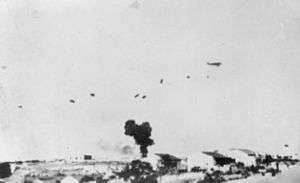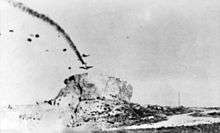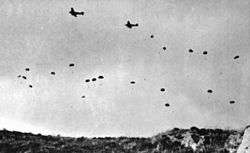Battle of Heraklion
The Battle of Heraklion was a battle during World War II on the Greek island of Crete.[1] It began on the morning of 20 May 1941, when Nazi Germany launched an airborne invasion of Crete under the codename Unternehmen Merkur ("Operation Mercury"). British, Australian and Greek forces defended Heraklion port and airfield.
| Battle of Heraklion | |||||||
|---|---|---|---|---|---|---|---|
| Part of World War II, Battle of Crete | |||||||
 A stick of German paratroopers exiting from a Junkers Ju 52 transport aircraft over the town of Heraklion during the German airborne assault on the north coast of Crete. The large smoke plume (centre) indicates the site of a German Ju 52, shot down by allied ground fire. | |||||||
| |||||||
| Belligerents | |||||||
|
|
| ||||||
| Commanders and leaders | |||||||
|
|
| ||||||

Background
With the surrender of Greece in 1941 Crete was thrust into the war. Of the seven airstrips on Crete,[2] The best equipped, and the only one with a concrete runway, was at Heraklion.[3] It was also the only one with any blast pens, to protect aircraft on the ground. However, it was still improvised in nature, with, for example, the fuel store located outside the positions defending the airfield.[2]
About 500 men from the 2/4th were evacuated by sea to Crete, arriving on 27 April.[4]
Allies
Heraklion was defended by the British 14th Infantry Brigade, which was made up of: the 2nd Battalion, the York and Lancaster Regiment (2nd York and Lancs); and the 2nd Battalion, the Black Watch (Royal Highland Regiment) (2nd Black Watch); with and the Australian 2/4th Battalion (2/4th) temporarily attached. On 16 May, four days before the battle, they were augmented by the 2nd Battalion, the Royal Leicestershire Regiment (2nd Leicesters), which was shipped in from Egypt.[5] Attached was the 7th Battery of the 2/3rd Light Anti-Aircraft Regiment,[6] the 7th Medium Regiment of artillery, 250 artillerymen fighting as infantry and the Greek 3rd, 7th and Garrison Battalions.[5] There were few artillery or anti-aircraft guns, but two heavy infantry tanks and six light tanks.[7] The whole force was commanded by Brigadier Brian Chappel.[5]
Chappel deployed the three Greek battalions in Heraklion town. The 2/4th was deployed to overlook the airfield from two hills, known as "the Charlies". To their west were the 2nd York and Lancs, the 2nd Leicesters and the 7th Medium Regiment. To their east were the 2nd Black Watch, on "East Hill, from which they could dominate both the airfield and the coast road. All units were well dug in and well camouflaged.[8]
Germans
The Germans believed that the total number of Allied troops at Heraklion was 400.[8] In fact it was over seven battalions, or "nearly enough infantry for a division".[9]
Battle

From the middle of May 1941 air attacks against Heraklion increased to four or five a day until 20 May when troop carriers dropped paratroopers at Maleme airfield on the west of the island. Warning reached Heraklion as their own share of German troop transports were spotted arriving at about 400 feet four abreast in long columns that stretched out of sight. This was the largest of the German parachute formations; it was made up of the 1st Fallschirmjager Regiment; the 2nd Battalion of the 2nd Fallschirmjager Regiment and an anti-aircraft machine gun battalion. All were under the command of Colonel Bruno Brauer.[10]
The three battalions of the 14th Brigade managed to kill or wound nearly all the German parachute troops who landed at Heraklion in this first wave, apart from a small pocket.[11]
In a matter of seconds the air was full of parachutes slowly descending to the ground. The moment the Battalion had waited for had come. Intense small-arms fire caused very heavy casualties among the enemy. Of those who escaped death in the air, the majority were killed on the ground, before they had time to get clear of their harness, by small parties of men rushing from their slit trenches with bayonets and bombs. The tanks and carriers also came out of their hiding-places and massacred all those who landed in the open.[11]
The enemy fared no better at the hands of the other units of the garrison. Of about 1,000 enemy troops who had come down inside the perimeter, over 900 of them had been buried by noon the next day. Small parties and odd individuals of course escaped, but these were mopped up during the next few days. Quite a large force, however, had fallen clear of the perimeter and parties of them were heard calling to each other after dark; they made no attempt to attack, being possibly too shaken by what had happened to their comrades. Thus the day ended in complete victory for the Heraklion garrison and the total failure of the Germans to achieve their object of capturing the aerodrome by direct airborne attack.[11]
After this attempt the Germans did not try to land any more paratroopers at Heraklion. Instead they built up their forces outside the perimeter. Before the Germans were able to complete the encirclement of Heraklion a company from the 1st Battalion, Argyll and Sutherland Highlanders joined the defence from Tymbaki on the south coast.[11]
The German forces, victorious from Battle_of_Maleme landed four more companies of troops in the vicinity of Heraklion which successfully linked up with the survivors of the first landings and launched attacks on the British positions. The fighting at times was extremely fierce but the Yorks and Lancs held their positions. By 28 May the position on the island as a whole had been lost and General Freyberg ordered a general evacuation. When the men of the 14th Brigade heard of the evacuation they were astonished;
as to them the whole battle of the last ten days had seemed to have been eminently successful.[11]
During the initial landing, the German paratroopers attacking the airfield were repulsed, but they successfully managed to establish a strong foothold around the Allied position, and after heavy fighting the battalion was withdrawn from town, being taken off the Heraklion mole aboard several British destroyers as the island fell to the Germans.[12] During the evacuation several of the warships that carried the 2/4th were subjected to heavy aerial attack, and several men from the battalion were killed or wounded.[13] After arriving in Alexandria, the battalion was rebuilt in Palestine, making up its losses from the earlier campaigns.[14]
Notes, references and bibliography
Notes
References
- http://www.awm.gov.au/collection/records/awmohww2/army/vol2/awmohww2-army-vol2-ch13.pdf Chapter 13 - Heraklion
- MacDonald 1995, p. 124.
- MacDonald 1995, p. 151.
- Unit History Editorial Committee 1963, pp. 139–144.
- MacDonald 1995, p. 152.
- Rae, CJE, Harris, AL & Bryant, RK 1987, On target: the story of the 2/3 Australian Light Anti-Aircraft Regiment from formation on 18th July 1940 until disbandment on 14 July 1943 and the subsequent service of 7th Battery, 8th Battery, and 9th Battery, until the end of World War II, 2/3rd Australian Light Anti-Aircraft Regiment Association, [Melbourne], http://antiaircraft.org.au/about-us/on-target.
- MacDonald 1995, pp. 153, 192.
- MacDonald 1995, p. 192.
- Long 1953, p. 281.
- MacDonald 1995, p. 191.
- Dillon 2006.
- Thompson 2010, p. 375.
- Unit History Editorial Committee 1963, p. 176.
- Unit History Editorial Committee 1963, pp. 204–205.
Bibliography
- 2/4th Infantry Battalion Unit History Editorial Committee (1963). White Over Green: The 2/4th Battalion and Reference to the 4th Battalion. Sydney, New South Wales: Angus and Robertson. OCLC 19985329.
Dillon, John (2006). "Battle of Crete". Archived from the original on 18 June 2007. Retrieved 6 April 2009.CS1 maint: ref=harv (link)
- Long, Gavin (1953). Greece, Crete and Syria. Australia in the war of 1939-1945. 2. Canberra: Canberra Australian War Memorial. OCLC 251302540.CS1 maint: ref=harv (link)
- MacDonald, Callum (1995). The Lost Battle: Crete 1941. London: Macmillan. ISBN 0-333-61675-8.CS1 maint: ref=harv (link)
- Thompson, Peter (2010). Anzac Fury: The Bloody Battle of Crete 1941. North Sydney, New South Wales: William Heinemann. ISBN 978-1-86471-131-8.CS1 maint: ref=harv (link)